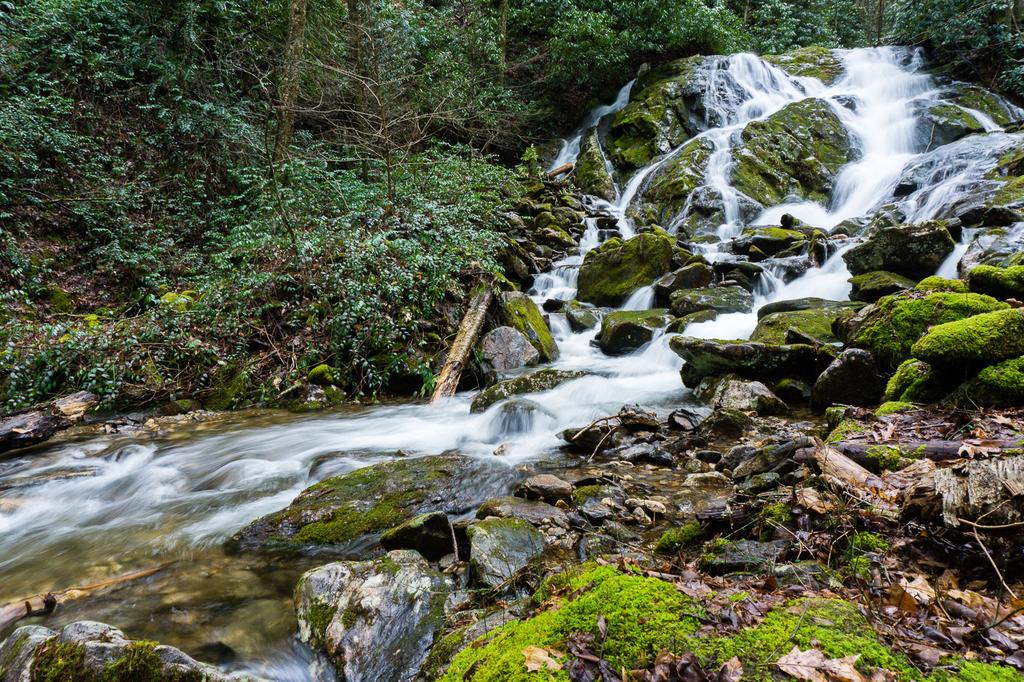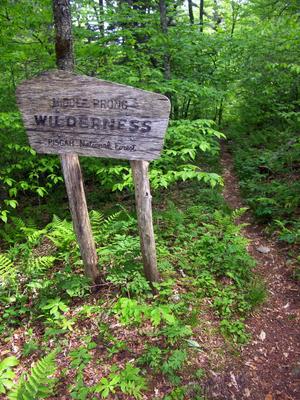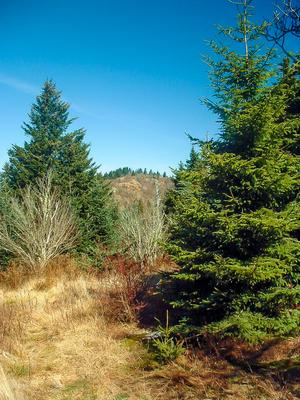Hiking the Middle Prong Wilderness Area
Overview
The Middle Prong Wilderness lies west of the Shining Rock Wilderness in the Pisgah Ranger District of the Pisgah National Forest, soutwest of Asheville, NC.
In this area, the Blue Ridge Parkway forms a big "U" and the Middle Prong wilderness occupies the western half of the U. The Shining Rock wilderness occupies the eastern half, and right down the middle runs NC Hwy. 215, which is the only thing that separates the two wilderness areas.


The Middle Prong is the smaller of the two wilderness areas, but still provides people plenty of room to spread out and enjoy a true natural experience in an area of exceptional natural beauty.
In light of this, NC 215 is where most access points for this wilderness area lie, starting with the Sunburst area in the north. Here the stream that drains most of the Middle Prong joins with the West Fork Pigeon River. Gravel forest service road 97 skirts the northern edge of the Wilderness and trails entering the heart of the area start here and generally travel south to the Parkway, which provides another possible access point for these trails.
The 7,900 acre wilderness was designated in 1984. Part of the reason of designating this area was to take some of the traffic away from the increasing visitation of the nearby, popular Shining Rock Wilderness. Next time you wish to take a hike into some spectacular, high-elevation terrain, or beside a crystal-clear, pristine mountain stream, consider a trip here - especially if you enjoy solitude.
Hiking Trails
Several designated trails, combined with the North Carolina Mountains to Sea Trail, form a loose network within the Middle Prong Wilderness. The trails are neither signed nor blazed, and receive minimal maintenance; however, they are for the most part easy to follow.

Buckeye Gap is a mountainside and ridgetop trail, which is extremely steep on one half and nearly level on the other.
Green Mountain is the longest trail in the Wilderness, and runs the length of the ridge that makes up the backbone of the entire area. It's a difficult trail which passes over the summit of Green Knob, one of the highlights of this wilderness. The upper portion of this trail makes up the Green Knob hike, one of the best in the region.
Haywood Gap is the area's primary streamside trail, as it follows Middle Prong upstream to a tributary with the same name as the trail, and ends in its namesake gap at the Blue Ridge Parkway.
This is just an overview of the trails in the Middle Prong wilderness area. For all the trail details, visit the Middle Prong Wilderness Trails page.
Interactive Trail Map
Map Information
Download GPS Data
Click on a route, trail, or point on the map and select the GPS Data tab to download its data.
Data Formats
KML (Google Earth)
KML is the main file type used by Google Earth. If you have Google Earth installed, clicking the KML link should open the trail or point directly in Google Earth for viewing. This is the native file format used by Google Earth, but many other map applications can use and understand KML as well, so if you're not sure which one to download, KML is a good bet.
GPX
The GPX format stands for GPS Exchange - a free, open, XML format for exchanging GPS and map data. GPX is compatible with Google Earth, many other mapping programs, and most GPS devices (such as Garmin). Load the file directly into your GPS to help find your way on your next trip!
GeoJSON
GeoJSON is a newer, lightweight data exchange format which can be used to quickly share map data and may have a smaller size than KML or GPX. Many professional mapping and GIS applications support the GeoJSON format.
About the Map
Copyright
Base Layers
Base layers provided by OpenStreetMap, the US Geological Survey, the US Forest Service, and NC OneMap. Base layer images are subject to the respective copyright policies of their owners. Base layers may not be available at all times due to system maintenance or outages.
WNCOutdoors Base Layer
The WNCOutdoors Base layer is provided by WNCOutdoors.info. It is licensed by Creative Commons Attribution 3.0.
Trail and Marker Overlays
Trail layers and downloadable data are all original works created by WNCOutdoors with guidance from a variety of sources, including ensembles of our own GPS tracks, user contributed GPS tracks, official maps and GIS data from government agencies, and field observations. WNCOutdoors data is made freely available under the Open Database License - you are free to copy and use it for any purpose under the terms of that license (summary).
Tips
- Hover over a trail to see it highlighted. Helps to see start and end points for an individual trail.
- Scroll and zoom the map before printing, and that view will persist into the printed image.
- Click a trail for more details and to download it individually.
Places to Stay
As with any wilderness area, there are no developed campgrounds in the Middle Prong Wilderness. Backcountry camping is allowed, but group size is limited to 10 and no open fires are allowed.
Several campgrounds are within a short drive, however, making day trips into the wilderness a possibility if you're staying in one of them:
- Sunburst, north of the wilderness area on NC 215
- Mount Pisgah Campground, North on the Blue Ridge Parkway
- Davidson River Campground, North on the Parkway and then East on US 276.




